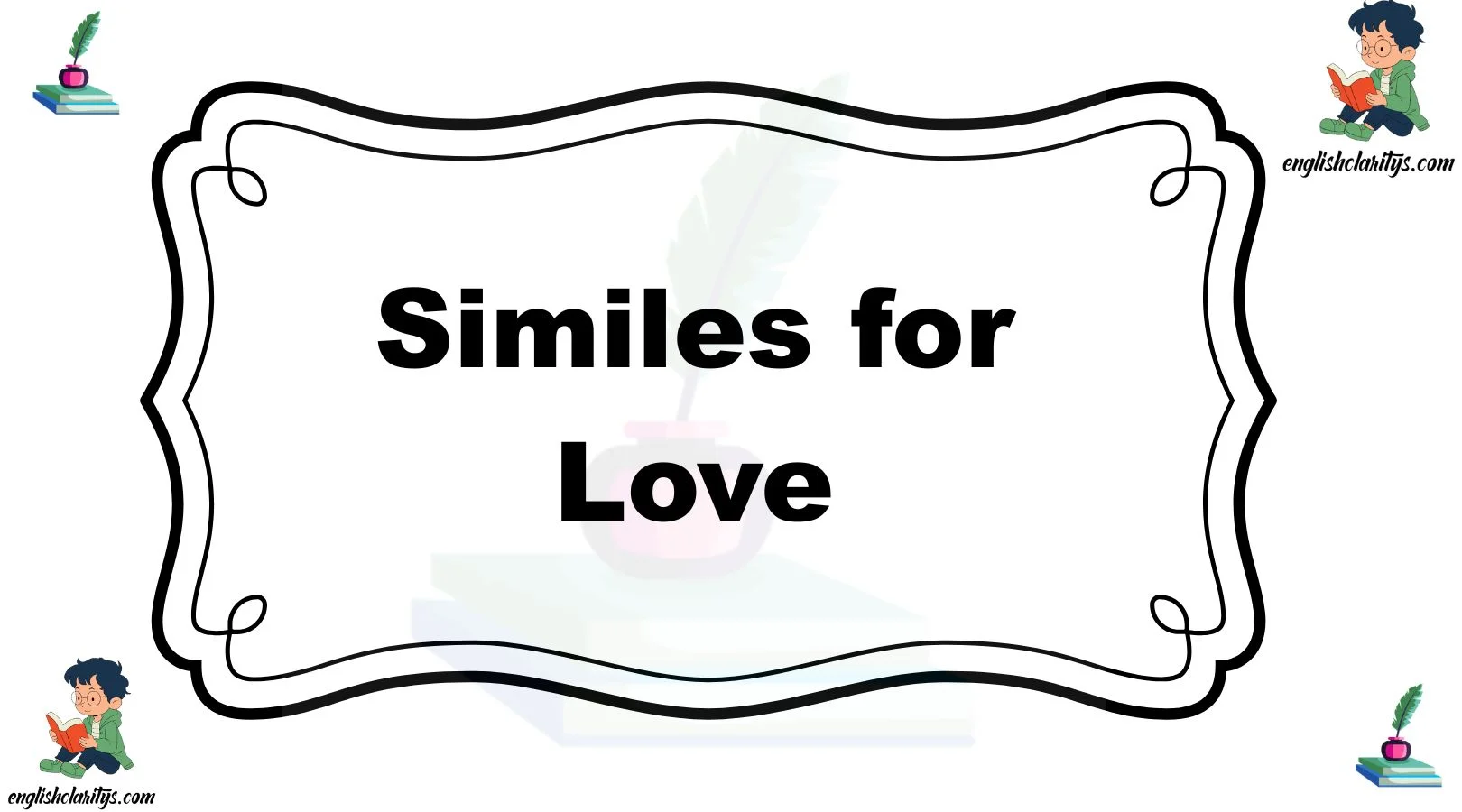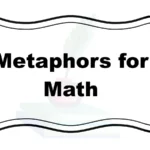Expressing love with the perfect words can turn a simple sentiment into something deeply personal, heartfelt, and meaningful. Whether you’re writing a card, speaking to someone special, or just reflecting on your feelings, using creative similes adds warmth and nuance. These comparisons help show not just that you love—but how you love. Let’s explore 25 similes designed to articulate love with care and authenticity.
What Does “Love” Mean?
Love is a deep, multifaceted emotion—a blend of affection, devotion, trust, and warmth. It can be gentle or passionate, constant or evolving. By choosing the right similes, we can pinpoint the unique shade of love we feel and communicate it in a way that resonates with others.
When to Use “Love” Similes
Use these similes when you want to elevate your expression—whether in romantic messages, letters to family, notes to friends, or creative writing. They work well for both spoken and written communication, helping you convey sincerity and emotional clarity.
Pros and Cons of Using Similes for Love
Pros:
- Brings emotional depth and vividness
- Makes your message memorable
- Helps others feel seen and understood
Cons:
- If overused, can seem cliché
- May not resonate with every audience
- Risk of sounding overly poetic in casual talk
1. Love is like the Sun
Definition: Radiant, constant, life‑giving affection.
Detailed Explanation: Just as the sun warms and nourishes life, this simile suggests love that supports and sustains you.
Scenario Example: “Your smile brightens my day—love is like the sun.”
Best Use: Describing dependable, comforting love.
Tone: Warm and uplifting.
Other ways to say it:
• Love is like sunshine
• Love is like daylight
• Love is like a summer day
2. Love is like a Garden
Definition: Needs care, patience, and grows over time.
Detailed Explanation: Just as a garden flourishes with attention, love deepens when nurtured.
Scenario Example: “Our relationship grew slowly—love is like a garden.”
Best Use: For enduring, evolving love stories.
Tone: Gentle and nurturing.
Other ways to say it:
• Love is like a flower bed
• Love is like a rose garden
• Love is like a blooming orchard
3. Love is like the Ocean
Definition: Vast, deep, and sometimes calm or wild.
Detailed Explanation: Evokes love’s immense and changing nature.
Scenario Example: “My feelings run deep—love is like the ocean.”
Best Use: When describing profound love.
Tone: Poetic and powerful.
Other ways to say it:
• Love is like the sea
• Love is like a tidal wave
• Love is like deep waters
4. Love is like Fire
Definition: Passionate, warm, and intense.
Detailed Explanation: Captures fiery, strong attraction.
Scenario Example: “Being with you strokes my heart—love is like fire.”
Best Use: Romantic or exhilarating love.
Tone: Intense and vivid.
Other ways to say it:
• Love is like flame
• Love is like a blazing ember
• Love is like wildfire
5. Love is like a Beacon
Definition: Guides, comforts, and leads you home.
Detailed Explanation: Like a lighthouse, love provides direction and safety.
Scenario Example: “In dark times, your love shines—love is like a beacon.”
Best Use: Describing protective, guiding love.
Tone: Reassuring and hopeful.
Other ways to say it:
• Love is like a lighthouse
• Love is like a guiding star
• Love is like a torch
6. Love is like Music
Definition: Harmonious, emotional, and uplifting.
Detailed Explanation: Like a melody, love resonates and stirs feelings.
Scenario Example: “Our laughter blends perfectly—love is like music.”
Best Use: Expressing joyful, emotive love.
Tone: Melodic and expressive.
Other ways to say it:
• Love is like a song
• Love is like a symphony
• Love is like a love ballad
7. Love is like a Puzzle
Definition: Complex, fitting, and rewarding when complete.
Detailed Explanation: Suggests two people finding pieces that match.
Scenario Example: “You complete me—love is like a puzzle.”
Best Use: For complementary relationships.
Tone: Reflective and sweet.
Other ways to say it:
• Love is like connecting pieces
• Love is like a jigsaw
• Love is like fitted parts
8. Love is like a Bridge
Definition: Connects, supports, and spans distances.
Detailed Explanation: Symbolizes overcoming obstacles together.
Scenario Example: “Your love keeps us close—love is like a bridge.”
Best Use: For long-distance or resilient partnerships.
Tone: Supportive and strong.
Other ways to say it:
• Love is like a link
• Love is like a pathway
• Love is like a bond
9. Love is like a Warm Blanket
Definition: Cozy, comforting, and safe.
Detailed Explanation: Evokes a sense of emotional warmth.
Scenario Example: “After a bad day, your hug—love is like a warm blanket.”
Best Use: Comforting love in difficult times.
Tone: Soft and reassuring.
Other ways to say it:
• Love is like a cozy quilt
• Love is like a soft throw
• Love is like a snug shawl
10. Love is like a River
Definition: Flows, adapts, and continues moving forward.
Detailed Explanation: Symbolizes changing but persistent love.
Scenario Example: “Together, we flow through life—love is like a river.”
Best Use: Dynamic, evolving love.
Tone: Calm and fluid.
Other ways to say it:
• Love is like flowing water
• Love is like a stream
• Love is like a current
11. Love is like Gold
Definition: Precious, rare, and timeless.
Detailed Explanation: Highlights value and lasting quality.
Scenario Example: “Your support shines —love is like gold.”
Best Use: Expressing admiration and honor.
Tone: Luxurious and affectionate.
Other ways to say it:
• Love is like a treasure
• Love is like a gem
• Love is like a precious metal
12. Love is like a Soft Breeze
Definition: Gentle, refreshing, and comforting.
Detailed Explanation: Conveys tender, easy-going affection.
Scenario Example: “Your kindness lifts me—love is like a soft breeze.”
Best Use: For calm, peaceful love.
Tone: Light and soothing.
Other ways to say it:
• Love is like a gentle wind
• Love is like spring air
• Love is like a balmy breeze
13. Love is like Chocolate
Definition: Sweet, indulgent, and comforting.
Detailed Explanation: Connects love with joy and treat-like satisfaction.
Scenario Example: “Moments with you are like chocolate —pure joy.”
Best Use: Warm, playful love.
Tone: Playful and sweet.
Other ways to say it:
• Love is like candy
• Love is like a treat
• Love is like dessert
14. Love is like a Rose
Definition: Beautiful, layered, and sometimes thorny.
Detailed Explanation: Emphasizes beauty and complexity.
Scenario Example: “Our love blooms—love is like a rose.”
Best Use: For romantic and elegant expressions.
Tone: Romantic and nuanced.
Other ways to say it:
• Love is like a blossom
• Love is like a flower
• Love is like a garden rose
15. Love is like Fireflies
Definition: Magical, fleeting moments illuminating darkness.
Detailed Explanation: Highlights precious, sparkly memories.
Scenario Example: “Our first kiss was glowing —love is like fireflies.”
Best Use: For nostalgic, magical love moments.
Tone: Enchanting and whimsical.
Other ways to say it:
• Love is like twinkling lights
• Love is like sparkles
• Love is like starlight
16. Love is like Coffee
Definition: Warming, energizing, and comforting.
Detailed Explanation: Symbolizes daily comfort and pep.
Scenario Example: “Morning with you feels full—love is like coffee.”
Best Use: Daily partnership and routine love.
Tone: Cozy and familiar.
Other ways to say it:
• Love is like tea
• Love is like a warm drink
• Love is like a morning brew
17. Love is like a Map
Definition: Guides and helps you find your way.
Detailed Explanation: Suggests shared direction and exploration.
Scenario Example: “You showed me the way —love is like a map.”
Best Use: Expressing gratitude for guidance.
Tone: Supportive and thoughtful.
Other ways to say it:
• Love is like a compass
• Love is like a guide
• Love is like a roadmap
18. Love is like a Puzzle Box
Definition: Intriguing, multi-layered, full of surprises.
Detailed Explanation: Highlights curiosity and discovery in love.
Scenario Example: “You surprise me daily—love is like a puzzle box.”
Best Use: Evolving, playful relationships.
Tone: Intriguing and joyful.
Other ways to say it:
• Love is like a mystery box
• Love is like treasure chest
• Love is like a secret drawer
19. Love is like Wings
Definition: Gives freedom, support, and uplift.
Detailed Explanation: Conveys encouragement and empowerment.
Scenario Example: “With you, I soar—love is like wings.”
Best Use: Celebrating supportive partners.
Tone: Inspirational and uplifting.
Other ways to say it:
• Love is like flight
• Love is like uplift
• Love is like a helping hand
20. Love is like a Fire
Definition: Warm, lasting, transformational.
Detailed Explanation: Emphasizes enduring warmth.
Scenario Example: “Our bond keeps glowing—love is like a fire.”
Best Use: Long-term love.
Tone: Steady and enduring.
Other ways to say it:
• Love is like a hearth
• Love is like embers
• Love is like steady flame
21. Love is like Jelly
Definition: Soft, wobbly, fun, and a little messy.
Detailed Explanation: Showcases playful, imperfect love.
Scenario Example: “With you, I’m my silly best—love is like jelly.”
Best Use: Lighthearted, spontaneous love.
Tone: Playful and relaxed.
Other ways to say it:
• Love is like pudding
• Love is like mousse
• Love is like custard
22. Love is like a Quilt
Definition: Patchwork of memories, warmth, and comfort.
Detailed Explanation: Symbolizes shared experiences woven together.
Scenario Example: “Our years together are a quilt of moments.”
Best Use: Reflecting on shared history.
Tone: Cozy and sentimental.
Other ways to say it:
• Love is like a blanket
• Love is like tapestry
• Love is like keepsake coverlet
23. Love is like Morning Dew
Definition: Fresh, gentle, renewing.
Detailed Explanation: Captures newness and subtle beauty.
Scenario Example: “Every morning with you is fresh—love is like morning dew.”
Best Use: Describing new or renewing love.
Tone: Soft and hopeful.
Other ways to say it:
• Love is like fresh dew
• Love is like morning light
• Love is like new beginnings
24. Love is like a Candle’s Glow
Definition: Gentle, intimate light, comforting in darkness.
Detailed Explanation: Evokes closeness and intimacy.
Scenario Example: “In your arms feels safe—love is like a candle’s glow.”
Best Use: Romantic, intimate moments.
Tone: Soft and intimate.
Other ways to say it:
• Love is like candlelight
• Love is like a soft flame
• Love is like flickering light
25. Love is like a Puzzle Adventure
Definition: Exciting, unexpected, always learning.
Detailed Explanation: Emphasizes journey, challenge, and fun.
Scenario Example: “Every day with you is a journey—love is like a puzzle adventure.”
Best Use: Expressing dynamic, evolving love.
Tone: Adventurous and affectionate.
Other ways to say it:
• Love is like a treasure hunt
• Love is like exploration
• Love is like a quest
Conclusion:
To love is to nurture, cherish, empower, and let go. Whether your love is like the sun, a river, or a garden, these similes help capture its essence—warm, playful, steadfast, or ever-growing. Choose similes that reflect your feelings in the moment, and your words will resonate with genuine care.
MCQs:
1. Which simile emphasizes gentle, intimate warmth?
A) Love is like a blazing fire
B) Love is like a candle’s glow
C) Love is like a roaring storm
D) Love is like a puzzle box
Answer: B) Love is like a candle’s glow
2. Which simile suggests that love needs care and patience to grow?
A) Love is like a garden
B) Love is like a wildfire
C) Love is like a puzzle box
D) Love is like a rocket
Answer: A) Love is like a garden
3. Which simile describes love as vast and deep, with calm and wild moments?
A) Love is like a river
B) Love is like the ocean
C) Love is like a mountain
D) Love is like a flower
Answer: B) Love is like the ocean
4. Which simile best represents passionate and intense love?
A) Love is like a warm blanket
B) Love is like a fire
C) Love is like a puzzle
D) Love is like a soft breeze
Answer: B) Love is like a fire
5. Which simile symbolizes love as something that guides and leads you?
A) Love is like a beacon
B) Love is like a map
C) Love is like a puzzle box
D) Love is like chocolate
Answer: A) Love is like a beacon
6. Which simile connects love with harmony and emotion, like a melody?
A) Love is like music
B) Love is like fireflies
C) Love is like a river
D) Love is like a garden
Answer: A) Love is like music
7. Which simile describes love as something that fits perfectly together, like matching pieces?
A) Love is like a puzzle
B) Love is like a bridge
C) Love is like a rose
D) Love is like a candle’s glow
Answer: A) Love is like a puzzle
8. Which simile portrays love as a connection that spans distances and supports?
A) Love is like a bridge
B) Love is like a garden
C) Love is like gold
D) Love is like jelly
Answer: A) Love is like a bridge
9. Which simile highlights love as a source of comfort and warmth?
A) Love is like a soft breeze
B) Love is like a warm blanket
C) Love is like a puzzle box
D) Love is like fireflies
Answer: B) Love is like a warm blanket
10. Which simile shows love as continuously flowing and adapting?
A) Love is like a river
B) Love is like a garden
C) Love is like fire
D) Love is like chocolate
Answer: A) Love is like a river
11. Which simile refers to love as precious, rare, and timeless?
A) Love is like jelly
B) Love is like gold
C) Love is like a map
D) Love is like a puzzle
Answer: B) Love is like gold
12. Which simile captures love as gentle, refreshing, and soothing?
A) Love is like a soft breeze
B) Love is like fire
C) Love is like a puzzle box
D) Love is like a blazing sun
Answer: A) Love is like a soft breeze
13. Which simile relates love to sweetness and indulgence?
A) Love is like a rose
B) Love is like chocolate
C) Love is like a bridge
D) Love is like fireflies
Answer: B) Love is like chocolate
14. Which simile highlights love as beautiful but sometimes complicated?
A) Love is like a rose
B) Love is like a puzzle box
C) Love is like a candle’s glow
D) Love is like jelly
Answer: A) Love is like a rose
15. Which simile suggests love provides freedom and uplift?
A) Love is like wings
B) Love is like a puzzle
C) Love is like a warm blanket
D) Love is like fireflies
Answer: A) Love is like wings
FAQs:
Q1: What is a simile, and why use similes to describe love?
A simile is a figure of speech that compares two different things using “like” or “as.” Using similes to describe love helps express complex emotions in relatable, vivid ways, making feelings easier to share and understand with warmth and care.
Q2: How can similes improve the way I express love?
Similes add color and depth to your words. Instead of simply saying “I love you,” using a simile like “My love is like a garden that grows every day” creates a more meaningful, heartfelt message that resonates deeply.
Q3: When is it best to use similes for love?
Similes work well in conversations, love letters, poems, or any personal expression where you want to show thoughtfulness and emotion. They are especially useful when you want to communicate feelings in a warm and memorable way.
Q4: Can similes for love be used in all types of relationships?
Yes! Similes can be adapted to fit romantic relationships, friendships, family bonds, and even self-love. The key is choosing comparisons that feel authentic and appropriate for your connection.
Q5: Are similes better than metaphors for expressing love?
Both similes and metaphors are powerful tools. Similes are often easier to understand because they clearly show the comparison, while metaphors imply it more subtly. Using both thoughtfully can enrich your expression of love.
Q6: How do I choose the right simile for my feelings?
Think about what your love feels like—Is it calming, fiery, growing, or comforting? Then choose a simile that captures that essence. Consider the tone and context to ensure your words truly connect with your listener or reader.
Q7: Can similes be too poetic or complicated?
Simplicity is often best when expressing heartfelt emotions. While poetic similes can be beautiful, make sure they’re clear and genuine so your message feels sincere and easy to relate to.
Q8: What tone should I use when using similes for love?
The tone should match your relationship and your feelings—warm, tender, playful, or passionate. Using the right tone helps your similes feel authentic and touching.




